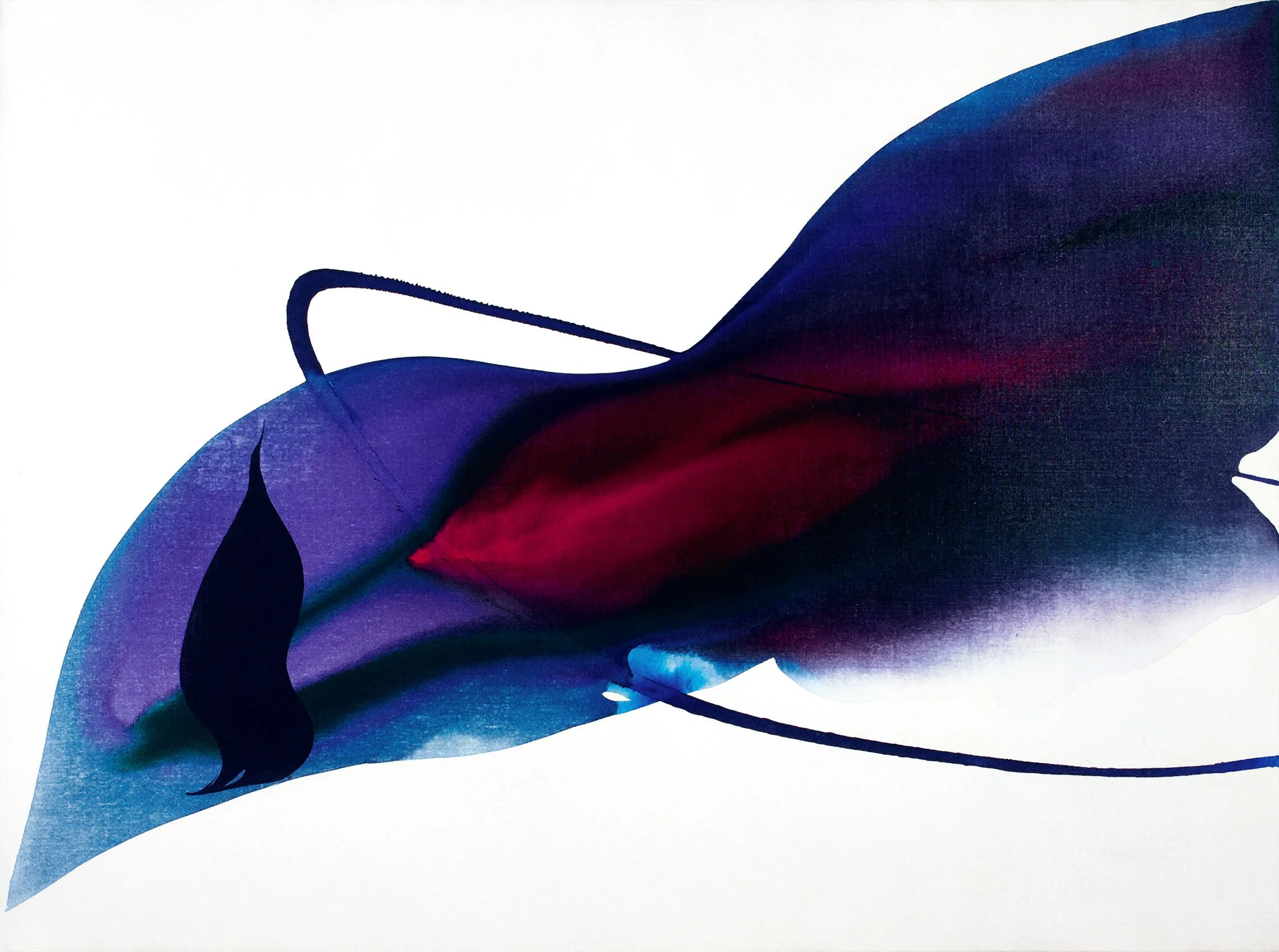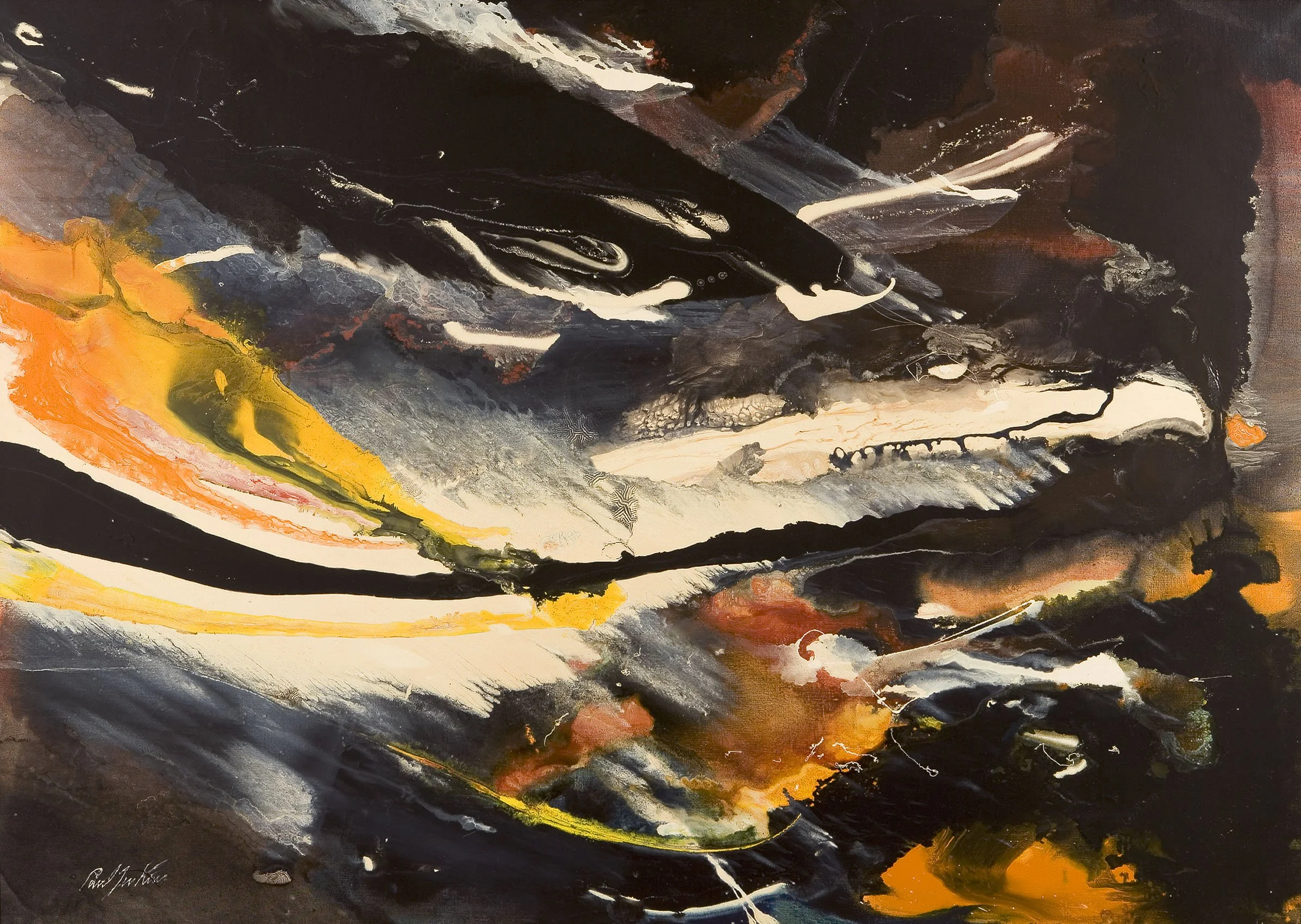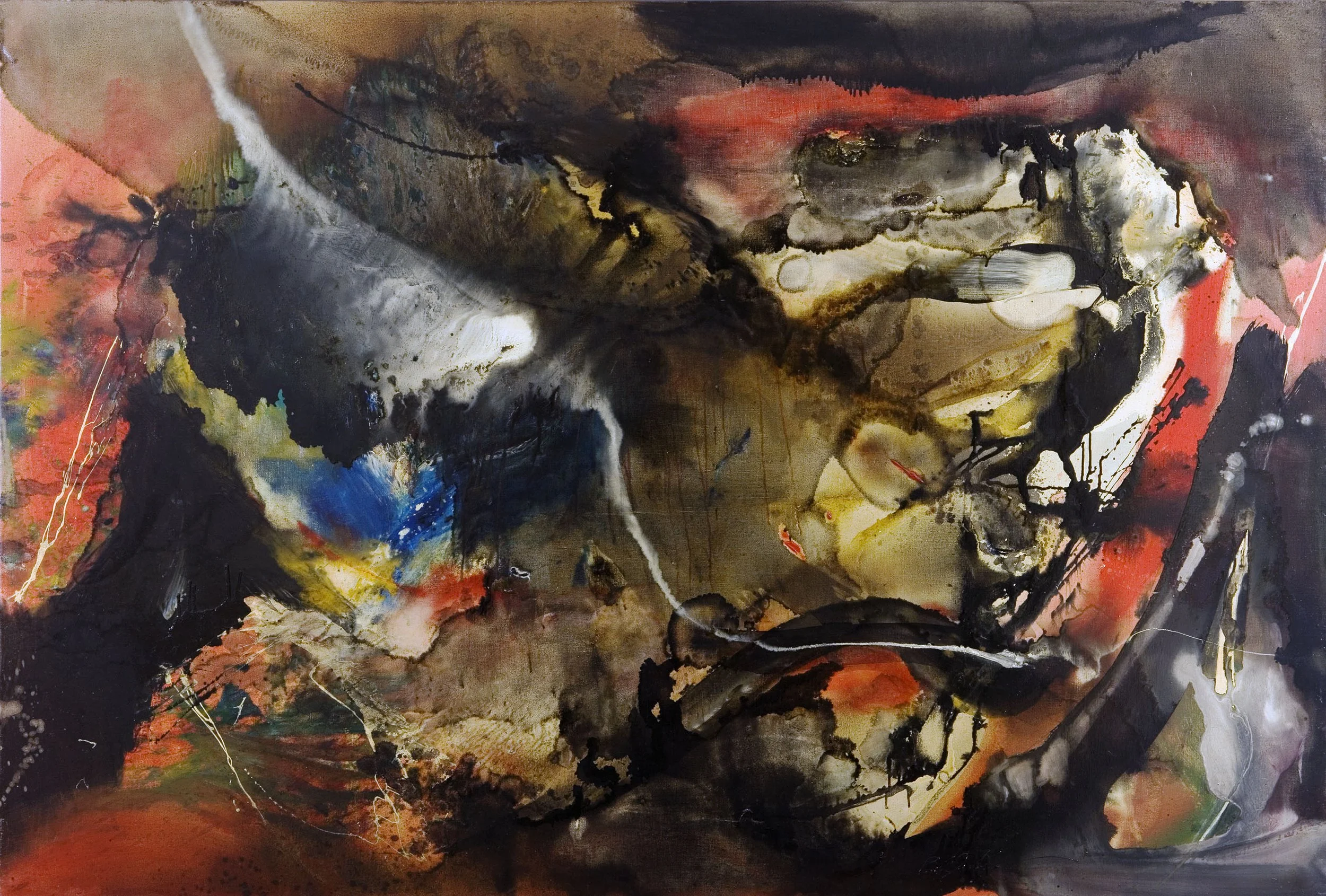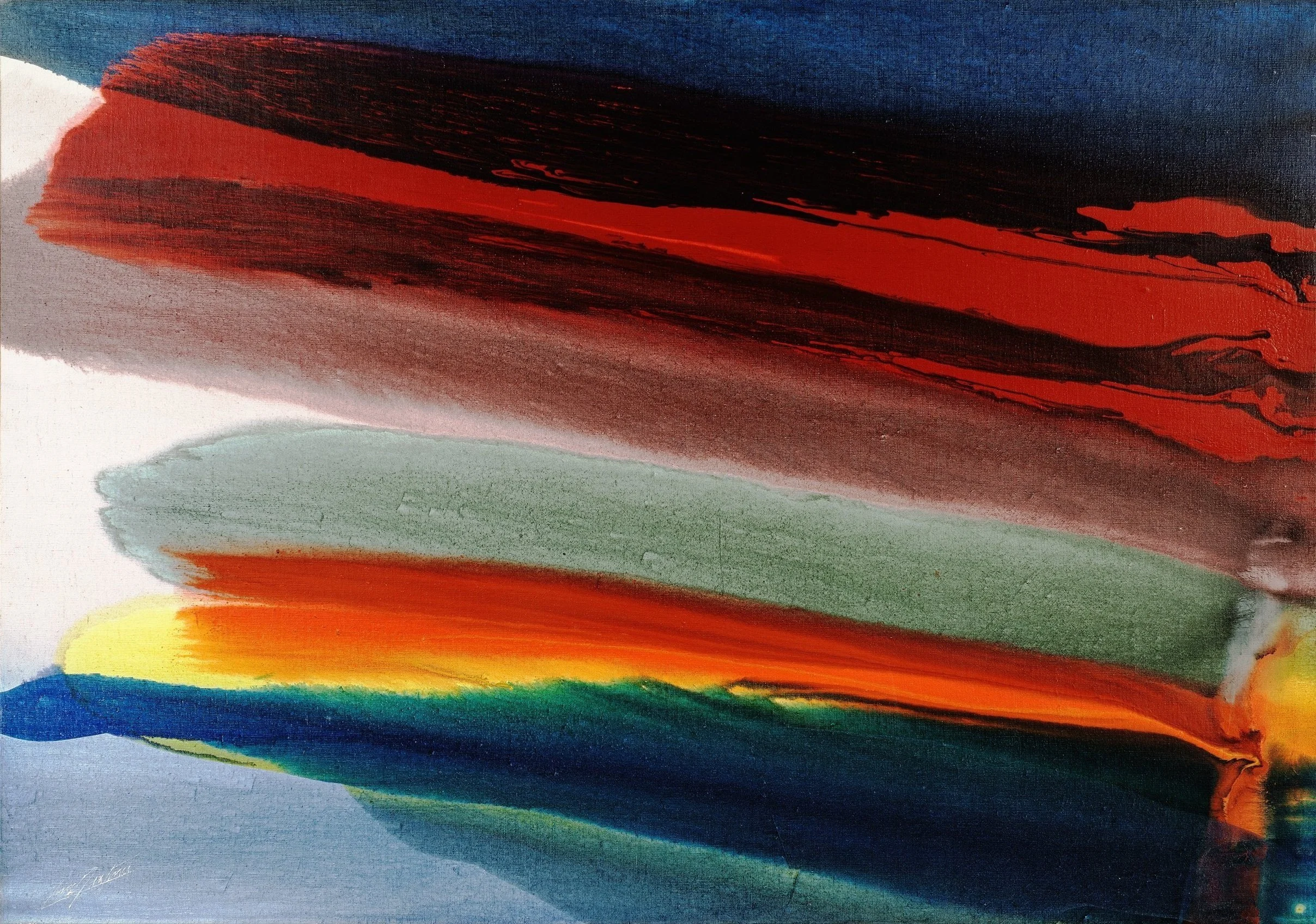Feb 24 - May 3, 2016
Press Release | Chronology | Solo Exhibitions | Group Exhibitions
Museum Collections | 2009 New York Times Review
Some works may still be available, please contact the gallery at 212-581-1657.
Press Release
D. Wigmore Fine Art, Inc. is pleased to announce its exhibition Paul Jenkins: Color and Flow featuring 12 canvases from 1956 to 1979. The exhibition offers a refined selection of all-over compositions in oil and enamel of 1956-1958, monochromatic works in acrylic from 1962-1963, and vibrant veil paintings of the 1970s. Across these decades, Paul Jenkins’ singular use of color and flow create an individualistic style that remains distinctively his.
The controlled flow of paint is fundamental to Jenkins’ technique. The balance of tension and timing essential to Jenkins’ work was something he first experienced working in a ceramics factory in high school. There Jenkins saw how the skilled ceramicists had to relinquish control to the heat of their kiln. As an artist, Jenkins replaced fire with the natural force of gravity, creating his imagery directly on the canvas during the act of pouring and manipulating the paint. As Albert Elsen wrote “his craft of painting is vital to the character of his imagery and to our prolonged enjoyment of it. What he has found in the confluence of chance, feeling and calculation is a sustaining source for richly diversified images.” (“Paul Jenkins: The Marvels of Occurrence,” Art International, March 2, 1964).
In the 1950s Paul Jenkins worked in oil and enamel, liquefying his medium to work in all-over compositions of color masses in sweeping movements. Throughout Jenkins’ career, color is essential to provide composition and structure. Yet the artist’s use of black and white is of equal importance in the three paintings from 1956-1958 in our exhibition. White chrysochrome enamel enabled Jenkins to create precise white lines as final points of contrast. In Skagerak, 1958, drifts of yellow rise from depths of blue and black while breaks of white chrysochrome lead the eye to the surface. In Albatross , 1956 flowing blacks are enlivened and shaped by reds and blues while openings of white chrysochrome act as a pathway out of the darkness. In Paris, 1957 amidst luminous flows of color is a core of black with calligraphic motions of white chrysochrome that lead the viewer into and up through the painting.
Helen Harrison noted the importance of movement in the 1950s works when she wrote, “Jenkins uses puddling, melting and chromatic blending to suggest movement not only across the surface but also beneath and beyond it.” (“Unveiling the Image,” text for Paul Jenkins in the 1950s: Space, Color, and Light, D. Wigmore Fine Art, 2005). Each 1950s painting in our exhibition is its own universe full of natural forces at work, creating a sense of scale independent of size with projecting and receding masses, a quality that makes Jenkins distinct among the leading Abstract Expressionists of the time.
A major transition in Paul Jenkins’ work came with his move to acrylic paints in 1960. As the artist continued to prepare the ground of his canvas to prevent the paint from soaking into the weave, acrylic allowed for greater manipulation and action in his paintings. At the same time, the role of white switched from the surface to the ground and Jenkins began to explore a more minimal, centered composition. Acrylic paints allowed Jenkins to achieve both opacity and translucency as seen in Phenomena Blue Ligeance, 1963 where blue paint is densely pooled in the lower half and thinly spread in a veil of blue-black in the top half. In the three paintings from 1962-1963 in our exhibition, Jenkins created complexly layered centered forms of limited color in contrast to the white background. In Phenomena Play of Trance, 1962 a rich red pushes out from a strongly delineated flow of near-black while a diagonal line anchors the base of the shape to the canvas. Gerald Nordland wrote of these new forms as “ambiguously flat and yet suggestive of both softness and stone-like solidity.”
By 1960 Jenkins titled his works beginning with Phenomena, which as Helen Harrison wrote, opened “the door to multiple interpretations of imagery that has no specific counterpart in nature yet seems somehow to refer to the natural world.” Each Jenkins canvas serves as its own world, engaging the viewer in his or her own memories and experiences. The titles in our exhibition evoke a sense of exploration with references to water, geology, and spirituality in distant lands.
The 1970s paintings in our exhibition demonstrate Jenkins’ mastery of technique and medium which he used to move freely between order and chaos. Phenomena Spectrum Hour Glass, 1974 and Phenomena Prayer Rug, 1975 recall elements of 1950s works with their all-over composition and turbulent movement. Granular white veils now replace chrysochrome to provide accents of light. These paintings have an atmospheric quality with evocations of natural forces of weather and sedimentation. In contrast, Phenomena Sufi Procession, 1974 and Phenomena Ore Shaft, 1974 show orderly veils of multiple colors that immerse the viewer in celebrations of color and calm. In both paintings, Jenkins uses the fast-drying nature of acrylic paints to move between distinct colors in translucent and opaque veils that overlap yet remain separate. Structure and movement come together in Phenomena Maimonides Mantle, 1979 where colors flow from a central point into joyous plumes of color. A granular quality in the central veils of purple and blue provides an additional dimension of texture. For Jenkins’ individual and distinct style, the flexibility of acrylic paint proved to be his ideal medium. In the 1970s Paul Jenkins’ technical expertise gave him great freedom to explore different forms of movement and structure depending on where his process led him resulting in a wider range of compositions.
Paul Jenkins used color and flow as tools to create paintings that remain timeless and continue to engage the viewer today in a moment of awe and imagination. As Jenkins said in his monograph Anatomy of a Cloud, “Abstractions are extractions from nature. Concentrates of nature.”
All images Ⓒ 2016 Estate of Paul Jenkins
[Top]
Modernism 1913-1950 | Realism of the 1930s and 1940s | Abstraction of the 1930s and 1940s | Post-War | Selected Biographies











